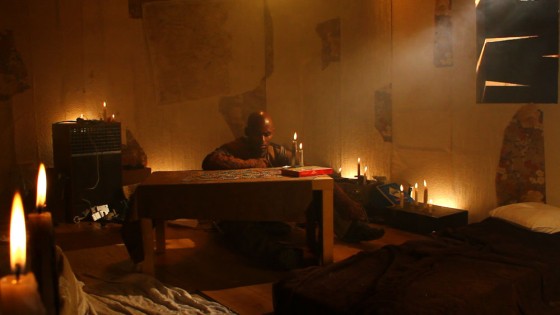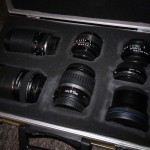You can now watch the trailer for Wasteland, the zombie feature I’m DPing and editing. And if you missed it first time round, why not read about how I lit this trailer?

You can now watch the trailer for Wasteland, the zombie feature I’m DPing and editing. And if you missed it first time round, why not read about how I lit this trailer?


You learn something with every job you do. On last weekend’s intensive shoot for Field Trip, I learnt a hell of a lot. Aside from one day filming the Wasteland trailer and a morning filming a corporate, it was my first use of my new Canon 600D and Pro Aim shoulder rig. Four days, up to seventeen hours each day, and every shot handheld: I could not have asked for a tougher crash course in HD-DSLR cinematography.

The director wanted a documentary style: lots of ad-libbed camera movements including crash zooms. It quickly became apparent that SLRs are not the right format for such a style, prone as they are to the rolling shutter “jelly” effect, and given that the lenses we were using noticeably adjusted the exposure – even in manual mode – whenever we zoomed. So that was the first lesson: choose your camera to fit your movie, and don’t just follow the crowd.
Aside from that, perhaps the key thing I realised is that I’ve bought into a system, a system which I can adapt to my needs and finances. This is true of both the rig and the camera. In the case of the former, I left off the follow focus and frequently the matte box and sunshades too, since these slowed down lens changes and made it harder for me to pull focus on the fly.

With the latter, lenses were the big revelation. To keep costs down, I didn’t purchase any lenses with my camera. I already owned Canon’s basic 18-55mm and 55-250mm zooms, and an adaptor would allow me to use my old 28, 50 and 70-210mm Minolta lenses too. None of these are particularly great, and crucially none of them are very fast. When I borrowed some f1.4 andf f1.8 primes from a helpful runner, I was blown away by the tiny depth-of-field. Conclusion: I’m wasting my camera’s potential with my current set of lenses, and I must get hold of some nice fast ones pronto.
Other things learnt or reinforced on Field Trip include: always make very sure the data has all been transferred before you wipe a card; you get what you pay for (one of my cheap third party batteries packed up); and I need some nice ND filters.
As ever, you’ll be the first to know when I get the new kit and how it stacks up. Thanks to James Byrne for the Field Trip photos.
Yesterday Ian Preece came over to do a sound test on my new Canon 600D HD-DSLR. Although the new wave of DSLRs capable of shooting full HD video are extremely popular with filmmakers these days, they are designed primarily for taking photographs, which can cause some problems for those more interested in motion pictures. The biggest one is sound.
As far as I know all the HD-DSLRs on the market have a microphone socket and some, like the 600D, allow you to manually adjust the recording level. But where they fall down is that none of them have a headphone socket, so there’s no way of monitoring the sound when you’re recording. If your lapel mic rustles on the interviewee’s jacket, or a gust of wind causes some rumbling, or the cable has been damaged and the sound is intermittently cutting out, you’ll be completely unaware until you play back the shot.
By far the best way to overcome this problem is dual system sound. This means, like shooting on film, you record the sound on a separate device and sync it to the picture later. (Typically with a clapperboard, but software like Plural Eyes can automate the process.) This is all well and good for drama shoots, but if you’re a one-man crew shooting a simple corporate or vlog, having to operate two devices and then spend the time in post syncing the footage is not ideal.
When researching my camera prior to purchase, I found that some people out there had discovered a way to monitor the sound being recorded to it. However, after receiving the camera and trying out this method, I discovered I couldn’t do it. It involved connecting a headphone amplifier to the AV out socket via a special cable. The problem is, as soon as you connect anything to that socket, the camera’s screen shuts off (since it assumes you’ve just plugged it into a TV). There is a firmware hack called Magic Lantern which prevents the screen from shutting off, but a full version is not yet available for the 600D (a relatively new model) and even when it is, I’m not sure I will want to risk it permanently damaging the camera.
(Note: Many DSLR filmmakers don’t care if their screen shuts off, because they’re using an external HDMI monitor as a viewfinder anyway. I’m not doing that, because the 600D has a flip-out screen, and when combined with a simple magnifying viewfinder attachment it becomes the perfect viewfinder.)
So I purchased a Beach Box, since these have a headphone socket. Okay, you’re not monitoring what the camera’s recording but you’re pretty close to it, and if you set it up correctly and keep checking the playback you should theoretically have no problems. Unfortunately, yesterday’s test with Ian did not go well. We tried first without the Beach Box, since he has a mixer with a headphone socket anyway. When this gave strange and unuseable results we turned to the Beach Box, which didn’t work either. Several weird things were going on, but the main one was that when we connected a mic to one stereo channel it came in incredibly loud and distorted, no matter how low we set the recording level, and on the other channel (which should have been silent) there was a very quiet, hissy version of the same audio.
It wasn’t long before we were forced to admit defeat. The Beach Box is going back whence it came, and I’m going to purchase a portable audio recorder and use dual system at all times. I’ll let you know how I get on with that in the coming weeks.
That’s all for now. Next time I’ll discuss the shoulder rig.